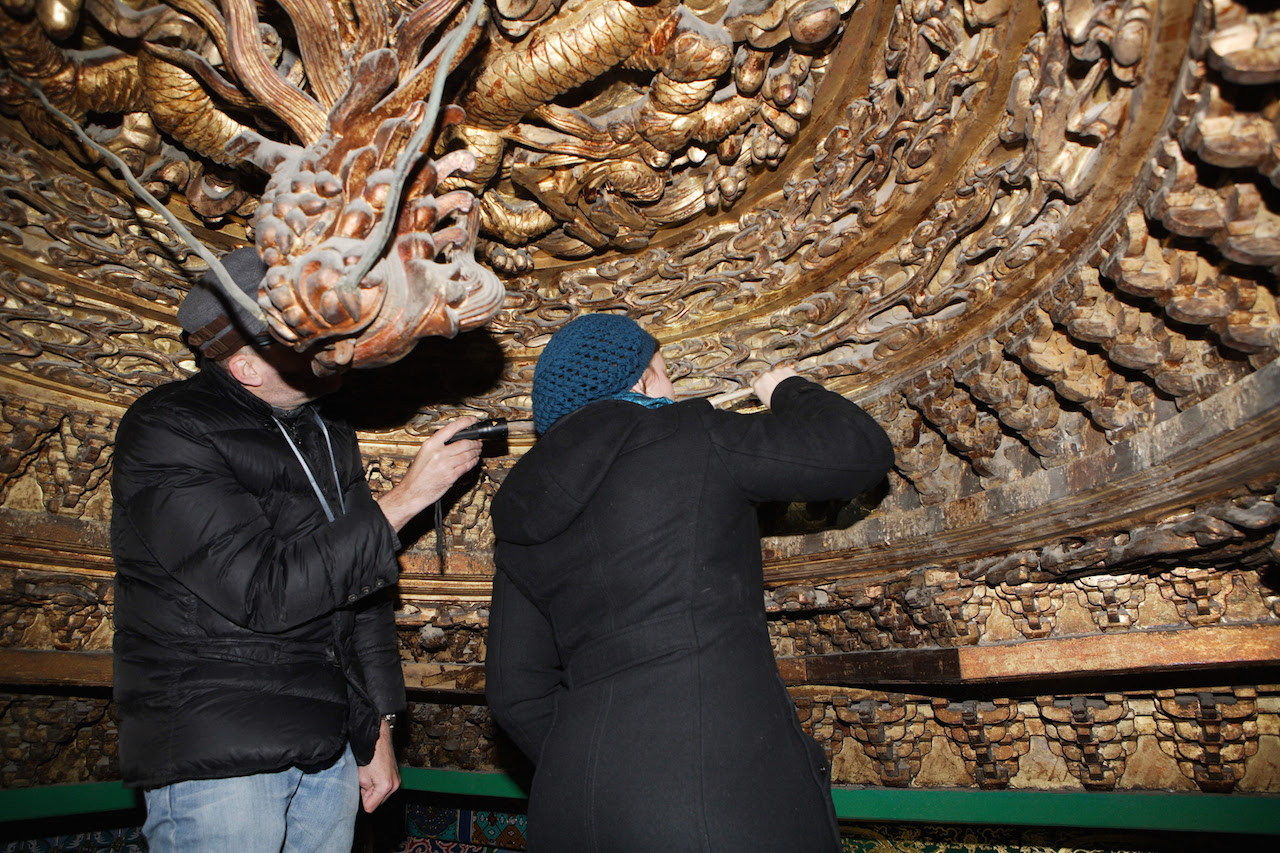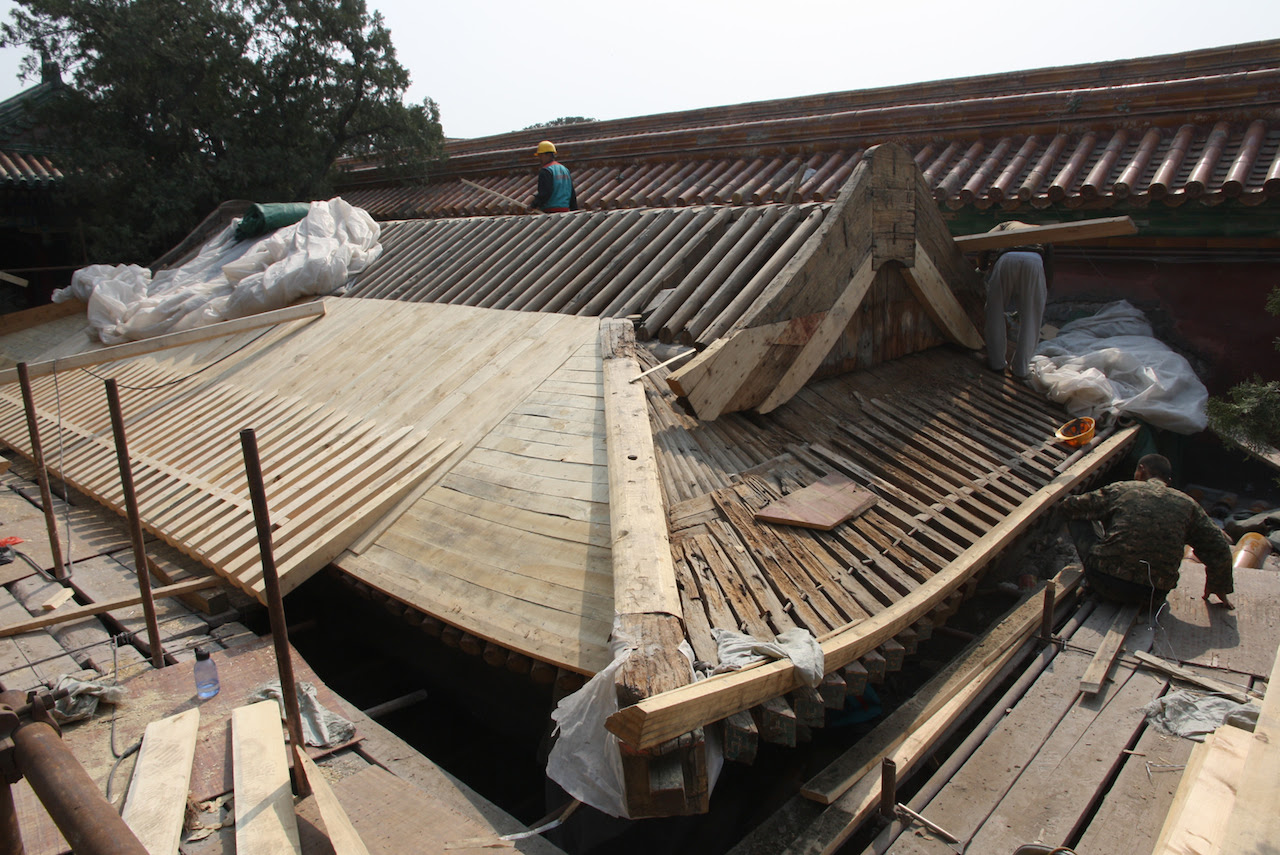Conservators Work to Open the Forbidden City’s Secret Garden to the Public
- by Allison Meier on March 15, 2016
by Allison Meier on March 15, 2016

Post-restoration interior of Juanqinzhai (2008) (photo by Si Bing/Palace Museum)
I visited the Forbidden City in Beijing this past November, and it felt endless. Courtyard after courtyard led to one stunning peaked structure after the next, with decorative rock formations and quiet corridors running along the sides of the walled complex. It was also mobbed with people — huge groups of tourists moving in packs while wearing color-coordinated hats — so that even the most obscure corners kept busy. It’s hard to imagine the place having secrets. Yet within the former imperial palace is an 18th-century garden that’s been closed since China’s last emperor departed, in 1924.
That secret garden is now being restored. In 2020, the long-forgotten retreat is planned to open to the public for the first time. The Qianlong Garden Conservation Project is a joint initiative between the Palace Museum, which manages the Forbidden City, and the World Monuments Fund (WMF). Last month WMF Senior Advisor Henry Ng discussed the project’s progress at a gathering of WMF’s Moai Circle at the bar Lumos. “Many of the threads were lost for how this place was built,” he explained, adding that the major challenge is retrieving traditional Chinese crafts that vanished in the country’s 20th-century cultural upheaval.
Similar to WMF’s collaboration with the Woodlawn Conservancy in the Bronx, for which a preservation education program was formed to continue stonework conservation, the Beijing project includes the founding of a new conservation studio in the Forbidden City, involving students from Tsing-hua University. The Forbidden City receives over 15 million visitors each year, making it one of the world’s busiest tourist sites. Having a dedicated, modern conservation facility to address the huge variety of art-making techniques found in the garden and other sites is crucial.
“They just don’t want the building to look the way it did, they want the original heritage and techniques,” Ng said of the conservation process. “Our own journey to find people who knew these techniques in a way mirrored the journey of the emperor.” Bamboo marquetry, silk painting, jade carving, and 18th-century glass art adorn 27 structures around four tree-lined courtyards in the Qianlong Garden, which was built between 1771 and 1776 as a retirement retreat for the Qianlong Emperor, the longest-reigning Chinese emperor. While objects from the period exist in museums, interiors are rare. These buildings hold some of the last, and finest, surviving examples. (Some of the garden’s furniture and interior objects toured the United States from 2010 to 2011 in the Emperor’s Private Paradise, organized by the Peabody Essex Museum with stops at the Metropolitan Museum of Art and Milwaukee Art Museum.)

Decorative ceiling conservation in Qianlong Garden (2013) (courtesy Palace Museum/World Monuments Fund)

Dragon detail from Qianlong Garden (2013) (photo by Henry Ng/Word Monuments Fund)
Much of the original craftsmanship in the garden came from southern China, and members of the conservation team traveled to these traditional art hubs. But the emperor was also interested in international innovations, such as European trompe l’oeilpainting, which he admired for its illusion of infinite space. As one of the world’s richest and most powerful people, he established an edict that, after his death, nothing would be changed, so the garden rests nearly unaltered over 230 years later. Just the same, researchers are examining 1930s photographs of the garden to see if they can discern whether any changes were made after the 1912 fall of the Chinese empire.

Historic wallpaper testing and conservation for Qianlong Garden (2011–12) (courtesy Palace Museum/World Monuments Fund)

Post-restoration interior at Juanqinzhai (2008) (photo by Si Bing/Palace Museum)
In 2008, the first major stage of the project was completed, with the conservation of the Juanqinzhai (Studio of Exhaustion from Diligent Service). It involved stripping the building to its skeleton and restoring silk trompe l’oeil paintings on the walls and ceilings of a private theater, as well as the intricate, threaded bamboo marquetry in a reception room.
Conservation was recently finished on the Fuwangge (Belvedere of Viewing Achievements), and now the focus is on the Zhuxiangguan (Lodge of Bamboo Fragrance) and Yucuixuan (Bower of Purest Jade). Each building has a totally distinct design, requiring constant research into different techniques. For example, the Lodge of Bamboo Fragrance is a sort of architectural book, with carved calligraphy and precious lapis lazuli decorating its wood.
“They pretty much turned the keys on these doors [in 1924] and left them dormant,” Ng said. Now life is slowly returning, but instead of being a private oasis, the Qianlong Garden will be a public resource for experiencing the lost crafts of 18th-century China.

Jade Purity roof conservation in Qianlong Garden (2013) (courtesy Palace Museum/World Monuments Fund)

View from second story in Juanqinzhai (2008) (photo by Henry Ng)

Fuwangge conservation on a roof in Qianlong Garden (2013) (courtesy Palace Museum/World Monuments Fund)

A view alongside the Lodge of Retirement in Qianlong Garden (2005) (photo by Michelle Berenfeld/WMF)



Nenhum comentário:
Postar um comentário